Aechmea striped, description and photo, planting, reproduction, care
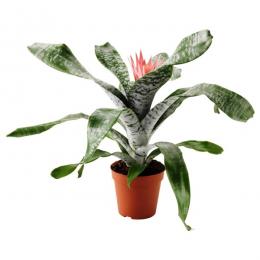
Aechmea striped is a decorative indoor plant, which is famous among flower lovers for its extraordinary beauty and exoticism.
The main thing when growing such flowers is to create optimal conditions and maintain them throughout your life. Now let’s figure out what kind of flower this is and how to properly care for it.
Content:
- Echmea striped, photo, description
- How to choose soil and plant the plant correctly
- Is it possible to replant flowering echmea?
- Rules of care
- When flowering begins, what to do when the echmea has bloomed
- How does echmea reproduce?
- Aechmea flower: meaning, what signs are associated with it
Echmea striped, photo, description
Aechmea is classified as a bromeliad. Native to South and Central America. There are more than 170 species in nature.
The flower is considered decorative; it is loved for its unpretentiousness, variety of colors and unusual appearance.
Striped echmea grows best indoors. This species was introduced to Europe from Brazil.
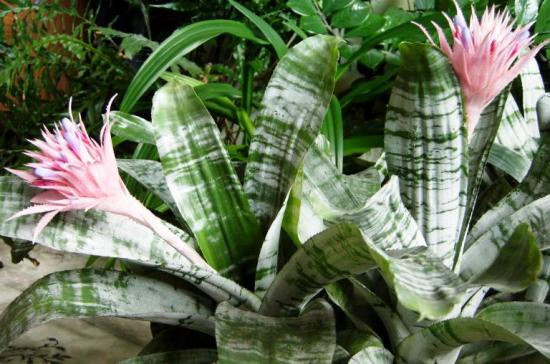
Characteristics:
- The height of the flower at home does not exceed fifty centimeters, the minimum height is thirty centimeters. Under natural conditions, it grows up to two meters in height, but at home this is impossible to achieve, since it is not possible to completely recreate the optimal climate.
- The leaf has a belt-like or linear shape, with a slightly pointed end and the presence of small teeth.The leaf length is about 60-70 centimeters, and the width ranges from 5 to 6 centimeters. The color is gray-green with stripes.
- The root system is weak, short, and shallow.
- The inflorescences are collected into buds, forming a flower in the middle of the rosette. The color is blue, sometimes the color can change to purple, blue or red. The plant blooms once in its entire life. This happens at the beginning of summer or in the last days of May. After the death of the rosette, children are formed, which are later used for reproduction.
The flower does not live long - about five years.
It is important to learn the nuances of cultivation and care.
How to choose soil and plant the plant correctly
Optimal soil For echmea, breathable, water-permeable and loose soil is considered. Such land can be purchased at a specialized store. Any soil designed for the bromeliad family will do.
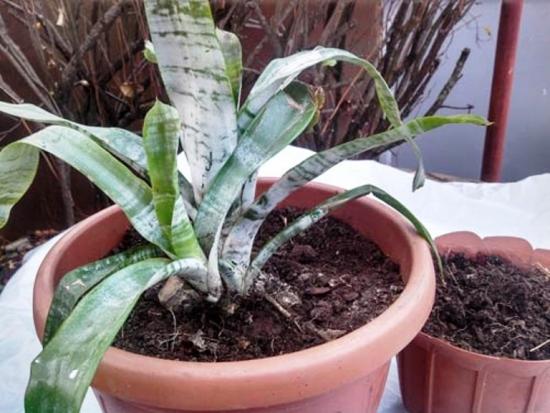
You can prepare high-quality soil yourself by mixing humus, peat or deciduous soil in equal proportions. Additional components used are charcoal, moss, sphagnum, sand and horn shavings.
It is important to ensure good drainage, this will avoid stagnation of water, which often leads to rotting of the roots.
Plays an important role choosing a flowerpot. The pot should be wide but low, since the roots are almost on the surface.
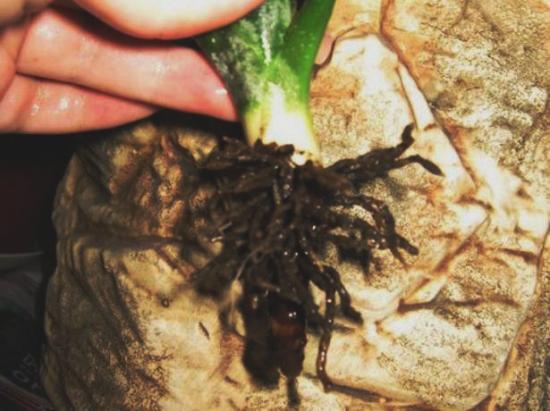
When working with a flower, you need to wear disposable gloves, since the sap of the plant is considered poisonous and can cause burns or severe irritation of the skin. After working with a flower, you need to wash your hands well with soap.
We invite you to watch the video and find out in more detail what Aechmea striped is and what care it requires:
Is it possible to replant flowering echmea?
It is prohibited to replant the flower during the flowering period. The plant already blooms once in its entire life, so starting replanting at an untimely time can harm the plant and contribute to the shedding of buds.
The transplantation procedure is carried out annually in the spring.
The following manipulations are performed:
- A new flowerpot is selected, which will be a little taller and a little wider than the previous one. The pallet is selected according to the container.
- In a new pot, fill half the container with high-quality substrate.
- The leaves are collected in a bunch near the root system and, with gentle loosening movements, the bush is removed from the old pot and immediately replanted in new soil. The procedure should not cause difficulties, since the roots weakly adhere to the soil, and it will not be difficult to remove it.
- The root system is covered with soil from above and placed in a specially selected place in the room.
- To quickly adapt, it is better not to water the flower for three days and protect it from ultraviolet rays.
Rules of care
Agricultural technology includes the following stages:
- Creating optimal lighting conditions. Aechmea does not like direct exposure to the sun's ultraviolet rays. Diffused lighting or partial shade is beneficial. If the flowerpot is on the north side, then to compensate for the lack of light, you need to install a phytolamp. In case of insufficient lighting, the color of the leaves changes, they become pale, lose their shine and presentability.
- Temperature regime. The flower requires a change in temperature in a certain season. For example, in the summer, the optimal temperature is considered to be from 25 to 28 degrees.In the winter months, the flower must be placed in a room where the temperature does not exceed plus 18 degrees, but not less than plus 16 degrees. A hot period or, conversely, a cold snap can lead to the death of the echmea. It is also very important that the room is constantly ventilated, since the plant needs fresh air. It is important to ensure that the flower is not in a draft.
- Humidity level. The plant is naturally found in a tropical climate, so the humidity level must be high. Particular attention should be paid to humidity during the heating season. Hot radiators and convectors make the air dry, and this negatively affects the foliage, it becomes yellow and twisted. To prevent damage, it is important to spray or pour wet expanded clay into pallets.
- Watering. Watering is necessary regular and frequent, especially in hot weather. Do not allow the soil to become dry. Excessive soil filling is also unfavorable and dangerous. Rain or purified water is used for irrigation. During the procedure, it is advisable to pour water not on the ground, but into a leaf outlet.
- Feeding. Fertilizers are introduced regularly, from April to September. The procedure is carried out every 10 days or two weeks. Use special minerals for this family as fertilizers. The liquid should be divided into a couple of parts, the first is poured into the leaf rosette, and the other into the soil.
By fulfilling these requirements, your house will be guaranteed to have a healthy plant with beautiful foliage throughout the year.
Let's watch a video about transplanting Echmea striped:
When flowering begins, what to do when the echmea has bloomed
Under natural conditions, the flower blooms after five years.But in houses or apartments you can cause flowering faster by creating favorable conditions for this.
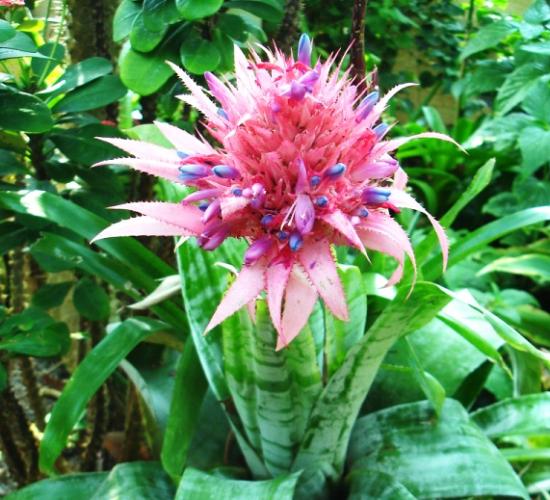
The flowerpot must be placed in a plastic bag, put a piece of banana, pear or apple inside, and lightly tie the bag.
Some people use the peel of these fruits. These products release a stimulant - the substance ethylene, which promotes flowering.
After fourteen days, the pot is taken out of the bag and placed in its original place. Over the course of 4-5 months, buds form.
After flowering is completed, the growth of the plant stops and it dies.
Young rosettes or babies are formed on the base, which can later be used for reproduction. After the end of flowering, the flower can throw out children in two stages, the first appear immediately, and the second - after planting the first daughter rosettes.
How does echmea reproduce?
The plant propagates by two methods:
- seeds;
- daughter sockets.
Seeds are planted in small containers containing sandy peat soil or fern roots. The seeds are not planted deeply, covered with a small layer of soil. Then the earth is lightly watered and covered with film material.
It is important to install the container with seeds where the temperature is no less and no more than 25 degrees. Every day the seeds need to be sprayed and opened for ventilation. Avoid direct exposure to sunlight. The first shoots appear within a month.
After 60 days, the seedlings are planted, placing them in separate containers.
Throughout the year, young plants need special care; it is important to keep them warm and maintain a high level of humidity. Next spring, a second transplant is carried out.
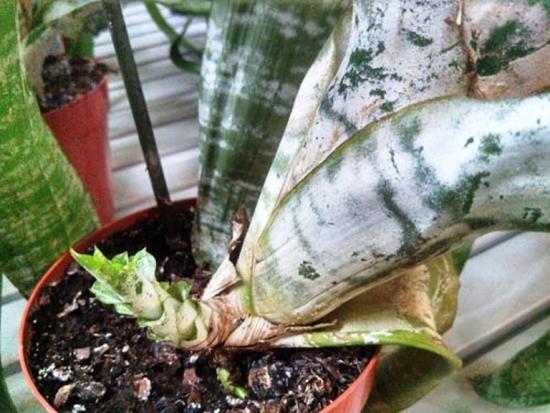
Daughter rosettes are separated when they become stronger and reach a height that corresponds to half or a third of the mother’s height. Transplantation is carried out in early spring. To do this, use shallow containers and special soil.
It is advisable to treat the cuts on the mother plant and on the young echmea with crushed charcoal. The children tolerate the transplant calmly and begin active growth in the coming weeks.
Aechmea flower: meaning, what signs are associated with it
Some gardeners are wary of this plant, while others associate it with stability and tranquility.
Aechmea is believed to promote a positive attitude and peace in the home. With regular care, stability is normalized, the person calms down and his life improves.
However, in ancient times the plant had a second name: “angel of death” or “angel’s trumpet”. This name is due to the presence of poisonous juice in the leaves.
If a small dose of juice enters the body, a person may lose consciousness; a large dosage can be fatal. It was believed that when the juice entered the body, a person suffered from such severe pain that he himself asked for death. Whether this is really so is not completely known; to believe it or not is for everyone to decide personally.
So, the echmea flower is a very beautiful and unpretentious plant.
Before purchasing it, you should familiarize yourself with the care requirements and follow these recommendations.

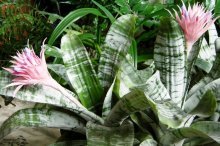
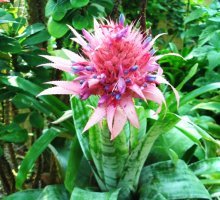
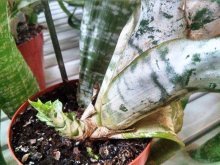
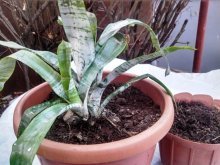
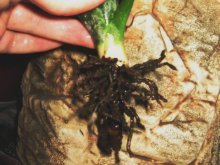
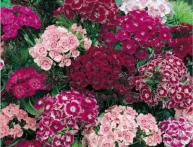

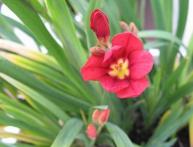
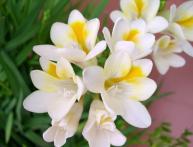
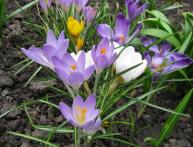
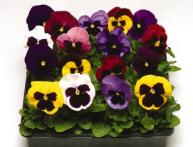

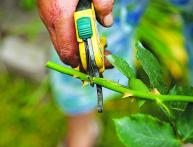
Comments
We have a similar flower growing at home, although it has never bloomed. Perhaps the matter is due to improper care of the flower. In the future, when growing, I will follow the recommendations of the article.